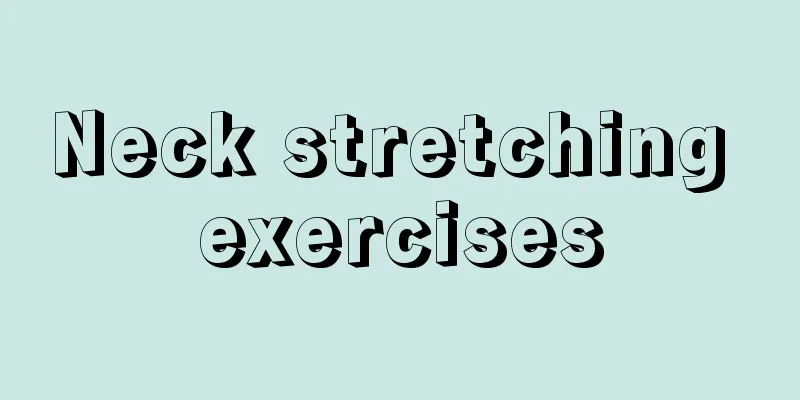Neck stretching exercises

|
Nowadays, cervical spondylosis is affecting younger and younger people. Many young people suffer from neck pain due to long-term work, study, playing with mobile phones, etc. The muscles in the neck begin to calcify over time, and in severe cases, neuralgia may occur. The best relief is to exercise your neck regularly and develop good neck usage habits. Here are some neck stretching exercises for you to check out. You need to warm up properly before stretching Neck stretching is also a whole-body exercise. You need to warm up properly before doing it. The specific steps are as follows: 1. Wiggle all your toes for 5 to 10 seconds. 2. Rotate your ankles for 5 to 10 seconds each. 3. Bend your knees for 5 to 10 seconds on each side. 4. Stand with your feet shoulder-width apart and rotate your hips for 5 to 10 seconds on each side. 5. Twist your torso back and forth for 5 to 10 seconds. 6. Rotate your shoulders, 5 to 10 seconds each side. 7. Bend your elbows for 5 to 10 seconds on each side. 8. Rotate your neck from side to side for 5 to 10 seconds. 9. Rotate your wrists, 5 to 10 seconds each side. 10. Move all your fingers for 5 to 10 seconds. Six simple stretches to easily stretch your neck Simple neck stretches are easy to learn. Let’s try them together with the help of a nurse’s personal demonstration. 1. Head and neck rotation ① Let your hands hang down naturally. Lift your chin slightly and look forward. ②Turn your head to the right and hold for 5 seconds. ③ Slowly return your head to the center position, rest for 5 seconds, and repeat the above steps on the other side. Parts that can be exercised: sternocleidomastoid muscle, splenius muscle, levator scapulae muscle, trapezius muscle, interspinal ligament, and capsular ligament. 2. Tilt your neck upward ① Let your hands hang down naturally. Slowly raise your head so that the tip of your nose is pointing upward to the right and your gaze is directed upward. ②Hold for 5 seconds. ③ Slowly return your head to the center position, rest for 5 seconds, and repeat the above steps on the other side. Parts that can be trained: sternocleidomastoid muscle. 3. Neck tilt ① Stand straight, let your hands hang naturally, slightly lift your chest, and press your shoulders slightly backward and downward. ② Slowly tilt your head to the right, feel the weight of your head shift to this direction, place your palms on your head and touch your ears with your fingers. Extend your other arm downward with your fingers straight, and hold for 5 seconds. ③ Relax your arms and slowly return your head to the middle position. Rest for 5 seconds, then repeat the above steps on the other side. Parts that can be trained: levator scapulae. 4. Neck stretch ① Cross your fingers and place them behind your head. ② Lower your head slightly and hold for 5 seconds. ③ Slowly return your head to the center position, rest for 5 seconds, and repeat the above steps on the other side. Parts that can be exercised: sternocleidomastoid muscle, nuchal ligament, supraspinal ligament, and trapezius muscle. 5. Triceps stretch ①Stand upright, lift your chest, and press your shoulders backward and downward. ② Raise your right arm behind your head with your elbow bent. The goal is to move your elbow to the center behind your head and place your right hand between your shoulder blades. ③ Grab the right elbow with your left hand, and while keeping the right elbow still, gently pull the right elbow with your left hand to intensify the stretch. ④Relax your elbow and repeat the above steps on the other side. Parts that can be trained: Triceps. Note: During this movement, avoid having your head and neck in the same direction and keep your spine in a straight line. Breathe evenly and don't hold your breath. 6. Biceps stretch ①Stand upright, lift your chest, and press your shoulders backward and downward. ② Interlock your fingers, place your hands behind your back, straighten your arms, twist your wrists inward, and bring your palms as close to your gluteal muscles as possible. Parts that can be trained: biceps, anterior deltoid, pectoralis major, pectoralis minor. |
<<: What department should I go to if my eyelids are twitching
Recommend
What causes dark circles under the eyes
If the eye sockets are dark, we need to consider ...
What to do if colon cancer is prone to recurrence after surgery
Experts say: Surgery is quite effective in treati...
How to prevent colorectal cancer
In fact, many diseases are caused by bad personal...
What are the effects and functions of mold tablets
In nature, there are many pathogens, such as Cand...
What are the precautions for esophageal cancer patients after surgery?
The treatment of esophageal cancer is important, ...
Tips for Thinning Hair
In life, most women have long hair. We all know t...
Can I get cured after suffering from skin cancer?
Skin cancer is one of the diseases on the skin, a...
Nervous enough to want to vomit
Human beings have seven emotions and six desires,...
What are the effects and functions of native chicken matsutake soup
Local chicken and matsutake soup is a great delic...
What are the symptoms of gastric cancer
Clinical symptoms of gastric cancer include: (1) ...
The harm of food pollution to human body
Nowadays, food contamination has become a very co...
What are the key points for diagnosing primary liver cancer? How to identify the symptoms of primary liver cancer
There are many symptoms of primary liver cancer, ...
Difficulty falling asleep and always having random thoughts
Can you fall asleep quickly? A very important rea...
How to judge whether you have a bad stomach
The stomach and intestines are an important part ...
How to care for patients with tongue cancer before surgery
For cancer, more and more patients choose to unde...









